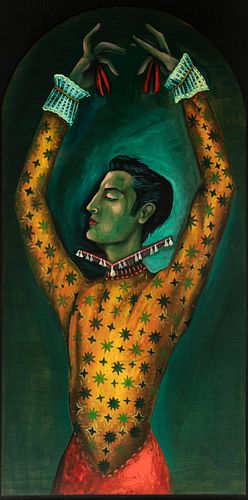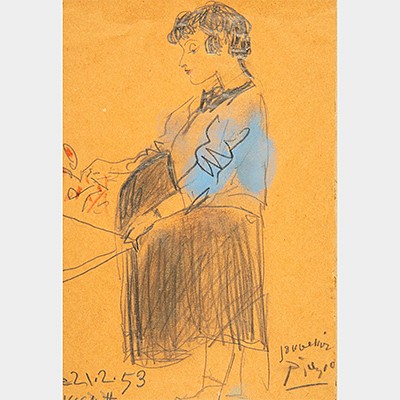JOAN PONÇ (Barcelona, 1927 - Saint-Paul, France, 1984). "Castanet player". Oil on panel. Signed on the back.
Lot 94
About Seller
Setdart Auction House
Carrer Aragó 346
Barcelona
Spain
Setdart Subastas was born in 2004 and is currently the first online art auction in Spain with solidity, prestige and reliability guaranteed by our more than 60,000 users. Setdart has a young, dynamic and enterprising team ready to successfully manage the purchase and sale of art works through custom...Read more
Estimate:
EUR€12,000 - EUR€15,000
$12,500 - $15,625
Absentee vs Live bid
Two ways to bid:
- Leave a max absentee bid and the platform will bid on your behalf up to your maximum bid during the live auction.
- Bid live during the auction and your bids will be submitted real-time to the auctioneer.
Bid Increments
| Price | Bid Increment |
|---|---|
| EUR€0 | EUR€10 |
| EUR€200 | EUR€25 |
| EUR€500 | EUR€50 |
| EUR€1,000 | EUR€100 |
| EUR€3,000 | EUR€200 |
| EUR€5,000 | EUR€500 |
| EUR€10,000 | EUR€1,000 |
| EUR€20,000 | EUR€2,000 |
| EUR€50,000 | EUR€5,000 |
About Auction
By Setdart Auction House
Sep 20, 2021
Set Reminder
2021-09-20 08:00:00
2021-09-20 08:00:00
America/New_York
Bidsquare
Bidsquare : CONTEMPORARY ART
https://www.bidsquare.com/auctions/setdart-auction-house/contemporary-art-7482
Setdart Auction House sofia@setdart.com
Setdart Auction House sofia@setdart.com
- Lot Description
JOAN PONÇ (Barcelona, 1927 - Saint-Paul, France, 1984). "Castanet player". Oil on panel. Signed on the back. Measurements: 112 x 45 cm; 130 x 73 cm (frame). Joan Ponç approached the world of flamenco on several occasions, as shown, for example, in his series of figures for Antonio Gades's ballet. In the present painting, the torso of a dancer in fancy dress is silhouetted against an emerald background, a colour Ponç often used to draw us into his nocturnal and magical universes. The figure raises her arms and waves her castanets. His face with its angular features expresses a concentrated intensity. A profane sacredness emanates from him, taking us through the use of colour and formal synthesis into the enigma of art, in this case, dance. A painter and draughtsman, Joan Ponç trained in Barcelona, in the studio of Ramón Rogent and at the Academy of Plastic Arts with Ángel López-Obrero. After devoting himself to painting and drawing in anonymity, he held his first individual exhibition in 1946 at the Galería Arte in Bilbao, which was to mark his definitive establishment on the national art scene. In 1948, together with Tharrats, Puig, Cuixart, Tàpies and Brossa, among others, he founded the avant-garde group Dau al Set. Selected by Eugenio D'Ors, he took part in the Salón de los Once in Madrid in 1951 and 1952. In 1952 he took part in the Hispano-American Biennial, and the following year he spent some time in Paris, where he met Joan Miró and managed to exhibit at the Musée de la Villa. On the latter's recommendation, Ponç gained access to Brazilian artistic circles, settling in São Paulo from 1953 to 1962. In 1954, the year Dau al Set disbanded, he held an exhibition at the city's Museum of Modern Art, with such success that the organisation acquired all his works. His career followed a circular path over the years, almost without evolution, if we understand as such the change from one language to another, the variation of styles, the transformation of the unknowns that led him to paint. Ponç was a painter-poet, who used his brushes to discover the only world he knew, the most real of all, the world that lies in the depths of his own being. It is a world inhabited by strange creatures with half-human, half-animal bodies, by demons who make us participants in their actions, by deserted spaces in which symmetrical mounds, craters in a line, Stygian lagoons under dark skies broken only by the glow of coloured moons stand out. He is currently represented at the Museo de Arte Contemporáneo de la Universidad de São Paulo, the Museo Patio Herreriano in Valladolid, the MACBA in Barcelona, the Centro-Museo Vasco de Arte Contemporáneo in Vitoria, the Museo de L'Empordà and the Museo Nacional Centro de Arte Reina Sofía.
- Shipping Info
-
In-house shipping available. Please inquire at admin@setdart.com.
-
- Buyer's Premium



 EUR
EUR CAD
CAD AUD
AUD GBP
GBP MXN
MXN HKD
HKD CNY
CNY MYR
MYR SEK
SEK SGD
SGD CHF
CHF THB
THB
















